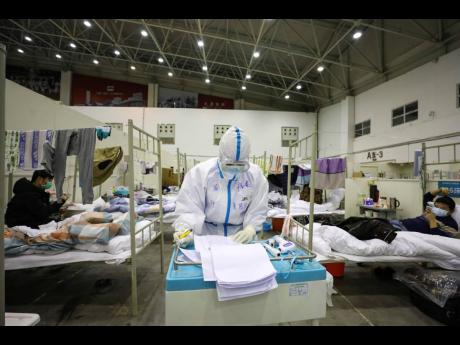New threats emerge in virus outbreak, while gov’t voices optimism
BEIJING (AP):
Chinese health officials expressed new optimism Thursday over a deadly virus outbreak, while authorities in South Korea’s fourth-largest city urged residents to hunker down as fears nagged communities far from the illness’ epicentre.
The confidence voiced by China’s government came as it reported a reduced number of new infections. But doubts remained about the true trajectory of the epidemic as China again changed its method of counting and new threats emerged outside the country.
“The downward trend will not be reversed,” insisted Ding Xiangyang, deputy chief secretary of the State Council and a member of the central government’s supervision group.
Whatever promises were aired where the illness poses its biggest threat, countries around the world continued to grapple with the rippling effects. The latest front in the widening global fight against COVID-19 emerged in Daegu, South Korea, where the city’s 2.5 million residents were urged to stay inside, wearing masks even indoors to stem further infection.
Mayor Kwon Young-jin made a nationally televised appeal for those preventative measures, warning that a rash of new cases could overwhelm the health system. He pleaded for help from the country’s central government.
Daegu and surrounding towns reported 35 new cases of the coronavirus on Thursday.
The flare-up came more than 1,400 kilometres (900 miles) from COVID-19’s epicentre across the Yellow Sea in China’s Hubei province and its capital of Wuhan, a sign of the risks the virus potentially poses to communities across the region and beyond.
“Everything that is not known about this is causing concern,” said Dr David Heymann, a professor of infectious disease epidemiology at the London School of Hygiene and Tropical Medicine.
Though all but about 1,000 of more than 75,000 reported cases of COVID-19 have been recorded in China, scattered cases have erupted elsewhere.
Iran announced three more infections Thursday, a day after the country’s state-run news agency, IRNA, reported its first two deaths stemming from the virus. In addition, South Korea reported its first fatality, and Japan said two former passengers of the Diamond Princess cruise ship had died of the illness, bringing the death toll there to three.
Other deaths confirmed by the World Health Organization outside mainland China include two in Hong Kong and one each in France, the Philippines and Taiwan.
The trajectory of the outbreak remained clouded by China’s zigzag daily reports of new cases and shifting ways of tallying them.
The number of new cases in China declined again Thursday, to 394, a notable shift from the 1,749 figure released a day earlier. Another 114 deaths in China were linked to the virus.
But those statistics came after yet another change in how cases are counted.

